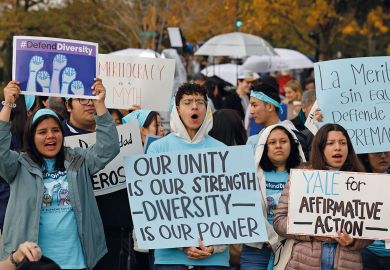California’s ban on legacy admissions is a symbolic victory for campaigners, according to experts, but they warn that institutions will need to be more creative to diversify their intake going forward.
The state legislature’s decision, which will block private non-profit institutions from admitting students based on their family ties, is seen by some as a direct response to the Supreme Court’s decision to outlaw affirmative action in admissions last year.
The legacy ban will not impact the University of California, which has barred consideration of legacy issues since 1998, but Mitchell Chang, interim vice-provost of equity, diversity and inclusion at the University of California, Los Angeles, said it would have a big effect on institutions such as Stanford University and the University of Southern California.
California was the fifth state to ban legacy admissions, but its national prominence means it will send a more important symbolic message, said Professor Chang, a professor of higher education and organisational change.
“It does signal to other states, especially the East Coast and the Ivies, that this is a move in the right direction in making admissions more equitable…but it’s not going to necessarily even the playing field,” he said.
Jinann Bitar, director of higher education research at advocacy group EdTrust, said legacy admissions exacerbated racial disparities, but the ban was unlikely to “move the needle” towards a more diverse student body.
Ms Bitar also doubted that California’s ban would hold much sway in some states, which “think of themselves as adversaries”, and it could make them less likely to follow suit.
However, she said that some private selective colleges have been “smart enough to see the headwinds” and halt legacy admissions of their own accord, and that more will follow.
Richard Kahlenberg, director of the American Identity Project at the Progressive Policy Institute, said the legislation, which comes into effect in September 2025, was a “matter of political necessity” for colleges that have become increasingly dependent on liberals’ support.
“If elite universities…hang on to this anachronistic practice of providing a benefit to the most advantaged students in American society, I think that liberal support will erode, and then higher education is left with nothing.”
He also traced it back to the Supreme Court verdict last year that brought an end to the “gentlemen’s agreement” that protected legacy preferences from civil rights groups.
“The energy behind banning legacy preferences accelerated dramatically when the Supreme Court ruled against racial preferences,” he said.
The end of affirmative action has been blamed by institutions, such as the Massachusetts Institute of Technology, for its intake becoming less diverse this year.
But affirmative action, although a great “stopgap”, was never a great way to increase access, particularly for competitive colleges, said Ms Bitar.
“We lost the stopgap, but we actually think this is actually an opportunity for higher ed leaders, state leaders, system leaders to come up with solutions that work,” she said.
“It’s been pretty devastating to see the downfall in admissions for students of colour, particularly black students across the board, but I don’t think it’s time to panic just yet.”
Bryan Cook, director of higher education policy at the Urban Institute, said eliminating legacy preferences was unlikely to lead to drastic changes in either the income or racial diversity of students at the most selective colleges.
He also warned that the “jury is still out” on how the Supreme Court decision has affected this year’s intake.
“Enrolment numbers that have been released are a mixed bag, with many schools experiencing declines in students of colour, some seeing no changes, and a few claiming increases in diversity.”
Register to continue
Why register?
- Registration is free and only takes a moment
- Once registered, you can read 3 articles a month
- Sign up for our newsletter
Subscribe
Or subscribe for unlimited access to:
- Unlimited access to news, views, insights & reviews
- Digital editions
- Digital access to THE’s university and college rankings analysis
Already registered or a current subscriber?








